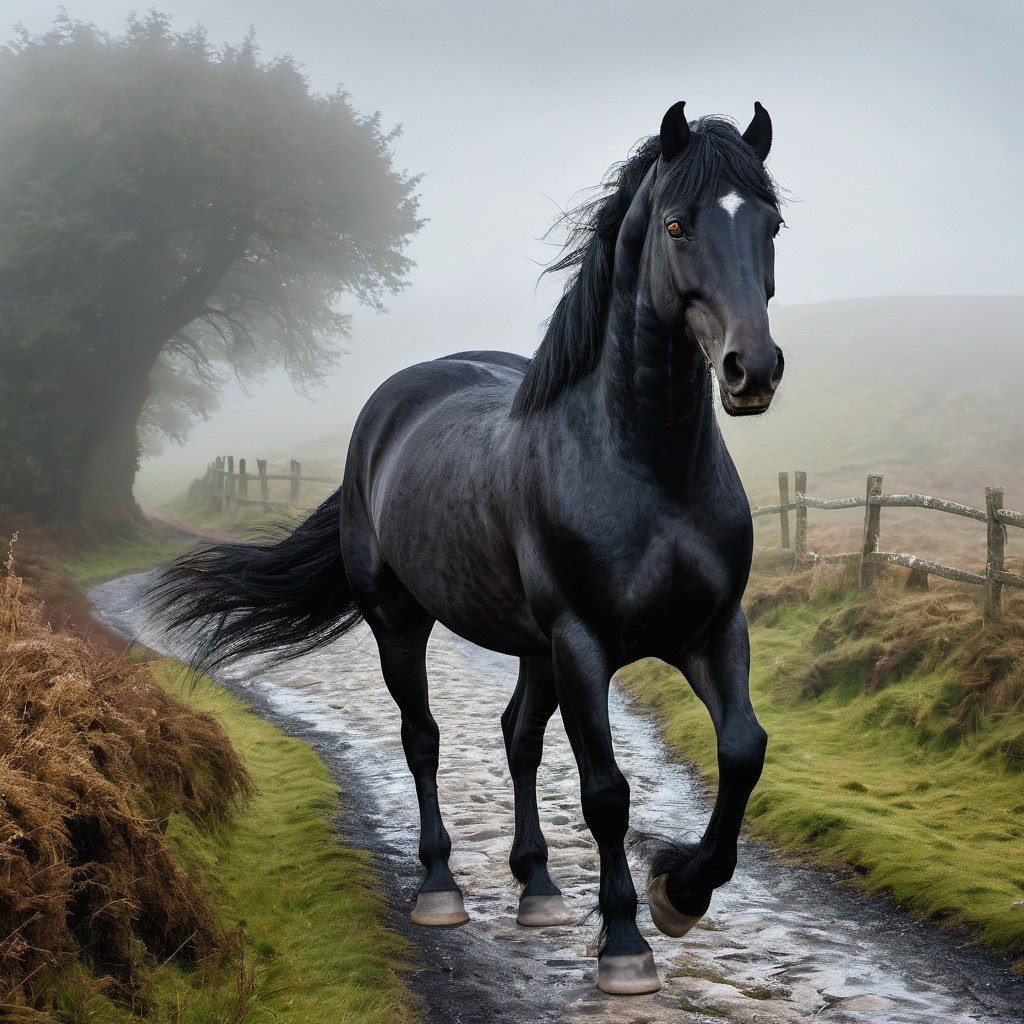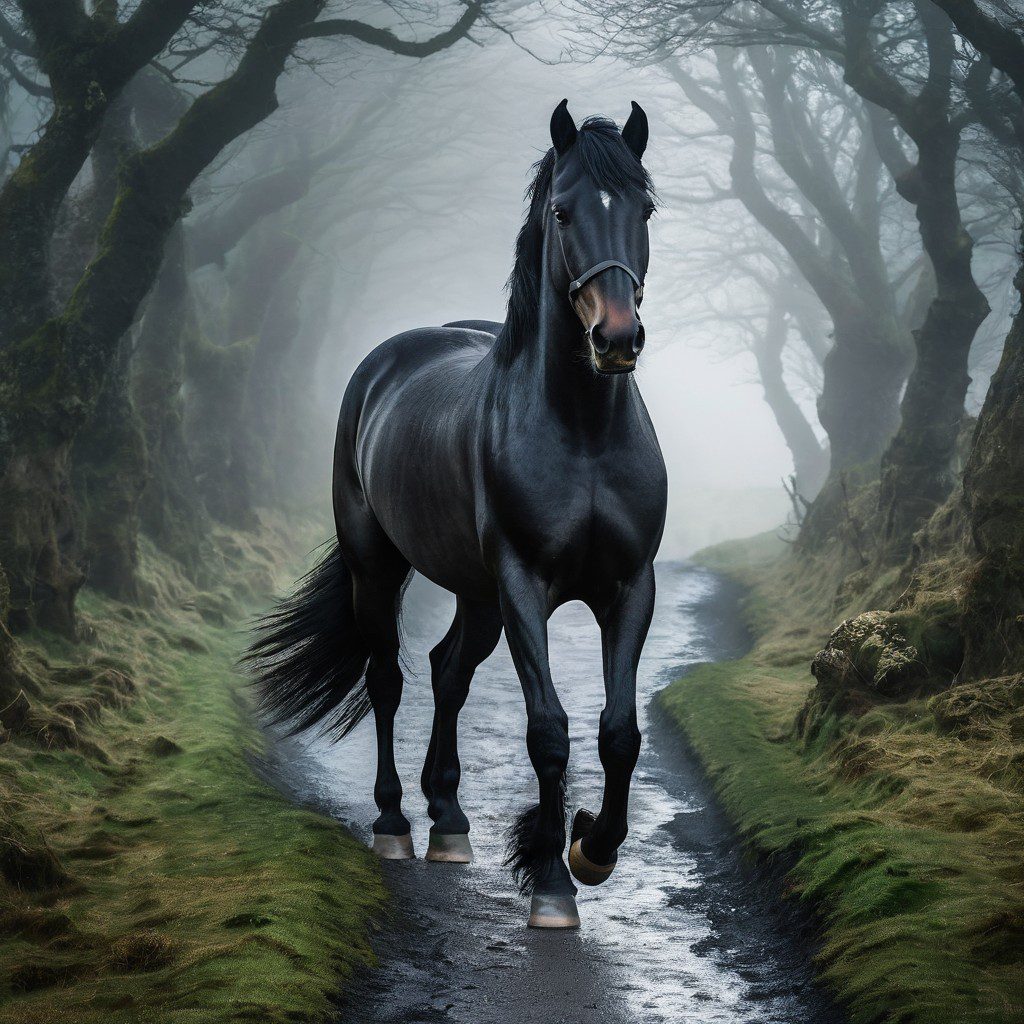Púca (Puck): The Shape-Shifting Trickster Spirit of Celtic Folklore

In the mystical hills and ancient woodlands of Celtic mythology, there lurks a mischievous and unpredictable spirit known as the Púca (also spelled Pooka or Phooka). With its ability to change shape and its love for pranks—both harmless and sinister—the Púca has become one of the most famous trickster figures in Irish and Welsh folklore. Known for taking various forms, from a black horse to a goat, hare, or even a human-like figure, the Púca’s true nature is often elusive and mysterious. While it can sometimes act as a helpful guide, more often than not, the Púca revels in chaos, upending the ordinary lives of those it encounters.
Though related to other mischievous spirits and fairies from European folklore, the Púca has a unique place in Irish and Welsh storytelling, where it is revered and feared in equal measure.
The Origins of the Púca
The Púca’s roots are found deep in Celtic mythology, where spirits and supernatural beings were believed to inhabit the natural world, particularly the untamed landscapes of Ireland and Wales. The name “Púca” likely derives from the Old Irish word “poc”, meaning goblin or spirit, though it is also related to the word for malevolent creatures across other European languages. The Púca, like many beings in Celtic mythology, can shift between various forms, often blurring the line between animal and spirit.
Though it is widely known for its trickster nature, the Púca’s role in folklore is complex. It can be a benign figure, offering advice or guidance to those it favors, but it can also be a vengeful and dangerous spirit. This duality is common in Celtic folklore, where many supernatural beings, like the Banshee or Dullahan, exist on the boundary between life and death, good and evil.

The Púca is most often associated with Samhain, the Celtic festival that marks the end of the harvest and the beginning of winter, a time when the veil between the human world and the spirit world was thought to be thin. As a result, Púca sightings were said to be more common during this time of year, when it would emerge to play tricks on those wandering after dark.
The Púca’s Shape-Shifting Abilities
One of the defining traits of the Púca is its shape-shifting ability. The Púca can take on many forms, each with its own symbolic significance, but it is most commonly seen in the following guises:
- A Black Horse: Perhaps the most iconic form of the Púca is that of a sleek, black horse with glowing eyes and a wild mane. In this form, the Púca is known to trick travelers by inviting them to ride on its back, only to race through the countryside at breakneck speeds, terrifying its rider. The Púca often leaves its victim stranded far from home or throws them into a ditch or swamp before disappearing into the night. Despite the Púca’s terrifying speed and unpredictability, those who survive the ride are said to never forget the experience, though they are often unharmed.
- A Goat, Hare, or Cat: The Púca is also known to appear as smaller animals like a goat, hare, or cat. In these forms, it may act more playfully, leading people on confusing chases through forests or causing minor mischief in villages. The goat form, in particular, was thought to symbolize the Púca’s connection to untamed nature and its trickster spirit.
- Human-Like Form: Occasionally, the Púca is said to take on a humanoid form, though it is rarely fully human. In some stories, it appears as a goblin-like figure or a dark, shadowy man, while in others, it can appear as a beautiful young man or woman to lure unsuspecting victims. Even in its human guise, the Púca’s glowing eyes or some other subtle animal feature often betray its supernatural origins.
- Mischievous Fairy: In some versions of the legend, the Púca is closely linked to the fairy world, particularly the Tuatha Dé Danann, the ancient race of deities and fairies in Irish mythology. This connection highlights the Púca’s ties to both mischief and magic, as it is often depicted as a fairy that revels in creating chaos among humans.
Though the Púca delights in mischief, it can also be a benevolent force when it chooses. In some tales, farmers would leave out offerings for the Púca at harvest time, particularly on Samhain, to appease the creature and ensure that it would not ruin their crops. A well-treated Púca could, in turn, bless the land, ensuring a bountiful harvest for the following year.
The Dual Nature of the Púca
The Púca’s unpredictable nature makes it a duality figure—both feared and respected in folklore. It is capable of bringing fortune and misfortune alike, depending on its mood or the treatment it receives from humans. In some stories, the Púca is a guardian spirit of the land, protecting crops and livestock if it is treated well, while in others, it is a vengeful creature that destroys crops or plays cruel tricks on those who cross its path.
This duality is reflected in one of the most famous tales of the Púca, in which the creature is transformed from a malevolent force into a helpful spirit:
- In the story of Brian Boru, the High King of Ireland, the Púca is tamed after it torments the people of a village. Brian Boru, known for his cunning and bravery, manages to trap the Púca using a special bridle enchanted with three hairs from the Púca’s tail. Once captured, the Púca promises to stop harassing humans and even offers its wisdom and predictions to those who seek its counsel. From then on, the Púca is seen as a wise, protective figure, able to offer guidance to those worthy of its favor.
In this way, the Púca is a reflection of the unpredictable forces of nature, embodying both its creative and destructive aspects. The Púca, like many trickster figures, teaches that there is a fine line between chaos and order, and it is up to humans to treat these forces with respect.
The Púca in Modern Media and Popular Culture
The Púca, like many other figures from Celtic mythology, has remained a popular figure in literature, theater, and modern media. The mischievous nature of the Púca has made it a perfect inspiration for fantasy and urban legend stories that explore the unpredictable and chaotic elements of the supernatural world.
One of the most famous depictions of a Púca-like figure is Puck from William Shakespeare’s A Midsummer Night’s Dream. Though Puck is technically a fairy, his role as a trickster and mischievous spirit who manipulates the human characters bears a striking resemblance to the Púca’s folkloric role. In fact, Shakespeare may have drawn on the Púca legend when crafting Puck’s character.
In modern literature, the Púca appears in books like Derek Landy’s Skulduggery Pleasant series, where it is depicted as a shape-shifting creature, as well as in Jim Butcher’s The Dresden Files, where Púca are portrayed as powerful but often capricious fae creatures.
In video games like The Witcher series and Assassin’s Creed: Valhalla, the Púca makes appearances as a mystical, shape-shifting creature that poses a threat to players or serves as an enigmatic character in a larger mythical context.
Strengths and Weaknesses of the Púca
Strengths:
- Shape-shifting Abilities: The Púca’s ability to change forms at will makes it a master of deception. Whether it takes the form of a horse, human, or another animal, its shape-shifting allows it to manipulate its environment and prey.
- Mischief and Trickery: As a trickster figure, the Púca excels in creating chaos, from leading people astray to playing pranks that confuse or disorient those who encounter it.
- Connection to Nature: The Púca’s close ties to nature, particularly during the harvest season, give it a powerful role in both the physical and spiritual worlds. It can bring blessings or ruin, depending on its treatment by humans.
Weaknesses:
- Unpredictability: The Púca’s dual nature means that it is often unpredictable. While this makes it powerful in terms of mischief, it can also lead to its downfall, as it may underestimate those who can trap or outsmart it.
- Respect and Offerings: Despite its chaotic tendencies, the Púca can be appeased through respect and offerings, particularly at Samhain. If properly honored, it can be persuaded to cease its tricks or even offer help to humans.
- Trapped by Magic: Like many supernatural beings in Celtic folklore, the Púca is vulnerable to magic. Stories like that of Brian Boru show that the Púca can be trapped or tamed if someone possesses the right knowledge or magical tools.
The Púca: Chaos, Mischief, and Magic
The Púca’s role in Celtic folklore as a trickster spirit reflects the ancient belief in the unpredictability of nature and the supernatural. Its shape-shifting abilities and love of mischief make it a powerful symbol of the fine line between order and chaos. Whether it’s racing across the countryside as a terrifying black horse or appearing as a wise advisor, the Púca serves as a reminder that the forces of nature—and the spirits that govern them—can never be fully controlled.
Though feared for its tricks and pranks, the Púca is also a protector of the land and a symbol of the cycle of the seasons, especially during the festival of Samhain. Its legacy continues to thrive in modern stories, where the Púca inspires new generations to embrace the magic, mystery, and unpredictability of the supernatural world.
Let me know if you’d like to explore more aspects of the Púca legend!
